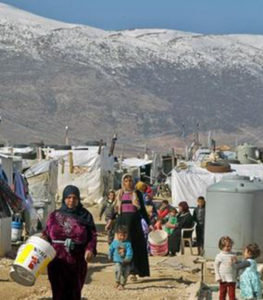New report reveals countries most welcoming to refugees
Lebanon, Jordan and Turkey have received the most refugees over the past decade, according to new data from the Norwegian Refugee Council (NRC).
Turkey has provided protection to more refugees than any other country in the last ten years. But in terms of refugees as a proportion of the total population, no country comes close to Lebanon in harbouring refugees between 2010 and 2019.
 The NRC data shows the countries that are most welcoming to refugees are mostly not wealthy nations.
The NRC data shows the countries that are most welcoming to refugees are mostly not wealthy nations.
In Lebanon, refugees represent 21.8 per cent of the population. With a population of 6 million, Lebanon is currently hosting an estimated 1.5 million refugees from Syria. The real number is probably even higher because the national authorities demanded that the UNHCR stop the registration of new refugees in 2015. There are also hundreds of thousands of Palestinian refugees living in the country.
Lebanon itself has been ravaged by a civil war that lasted from 1975 until 1990. It is a densely populated country with a fragile political balance between different ethnic and religious groups. The recent massive explosion at fertiliser store in Beirut has exacerbated an already parlous economic.
Unemployment is high and the country’s currency has dropped in value by 85 per cent, meaning much of the population is no longer able to afford the necessities of survival. Recent surveys put more than 50 per cent of the population below the poverty line. For Syrian refugees, the figure is even higher, with 83 per cent living below the extreme poverty line.
On top of this came the Covid-19 pandemic and the Beirut explosion, which killed more than 200 people, wounded more than 6,000 and displaced around 300,000.
The NRC says Lebanon now has an urgent need for the rest of the world to step up and help the country that has taken the greatest responsibility for helping displaced people.
Almost 11 per cent of people living in Jordan are refugees. The nation has received more than a million refugees in the last ten years, the NRC data shows. The vast majority were fleeing neighbouring Syria. Some have been able to return or have travelled on to other countries, but there are still 660,000 Syrian refugees living in Jordan today.
Unlike neighbouring Lebanon, Jordan has set up large refugee camps for Syrian refugees, which have developed into small towns. These tend to be situated in remote areas and, consequently, many refugees choose instead to try to find their own housing near the larger cities in the hope of being able to find work. Jordan also houses 2.3 million Palestinian refugees. These are people who fled or were expelled from their country during the 1947-49 Palestine war and the Six Day War in 1967, and their descendants.
Turkey has received more refugees than any other country since 2010 – as many as 4.3 million, or 5.1 per cent of the population.
Turkey is a large and populous country and is better equipped to handle the challenge but still faces challenges in providing protection to such a large number of people within a few short years.
Liberia is another country that has shown great hospitality to displaced people. It has received 230,000 refugees, representing 4.6 per cent of the population.
Liberia went through a long and bloody civil war just a few years before it opened its doors to refugees from the Ivory Coast. It was also hit hard by Ebola, which meant that refugees from the neighbouring country could not return home as quickly as the UN refugee agency had planned.
Uganda, which has received 1.7 million refugees, representing 3.8 per cent of the population, has for many years been one of the largest recipients of refugees in the world.
In recent years, Uganda has provided protection to people from DR Congo and South Sudan in particular, but the country has also received refugees from Burundi, Somalia, Rwanda and several other countries. Uganda is a pioneer in integrating refugees and giving them full rights.
Malta is the Western country that has received the most refugees relative to its population at 2.7 per cent.
The country is located near the coast of North Africa and receives many refugees and migrants trying to reach Europe from Libya. The pressure has become even greater since Italy has made it almost impossible for rescue vessels to dock at its own ports.
Djibouti has received almost 27,000 refugees, or 2.7 per cent of its population, mainly from the civil war in neighbouring Somalia. It is one of the smallest countries in Africa and has few resources.
Sweden has long had the most generous refugee policy in Europe and, unlike many other countries, has actively welcomed refugees. But the large influx of refugees to Europe in 2015, where many European countries were unwilling to share the responsibility, led to a temporary law that limits the rights of refugees to a minimum of what the country has committed itself to through international conventions. Despite this, Sweden still receives far more refugees than most European countries, with numbers currently at 2.7 per cent of its population.
With over one million refugees since 2010, or 2.5 per cent of its population, Sudan is the sixth largest recipient country in absolute numbers. Most have fled the conflict in neighbouring South Sudan. Sudan is also a key transit country for refugees from Eritrea, Ethiopia and Somalia, among others, who are trying to flee to Europe.
Other major recipient countries include: Germany – 1,191,000 refugees (1.5 per cent of the total population); Ethiopia – 962,000 (0.9 per cent); United States – 838,000 (0.25 per cent); Bangladesh – 675,000 (0.4 per cent); Kenya – 470,000 (0.9 per cent); Russia – 449,000 (0.3 per cent), and; Cameroon – 396,000 (1.6 per cent).
See the full NRC report here: https://www.nrc.no/perspectives/2020/the-10-countries-that-receive-the-most-refugees/












